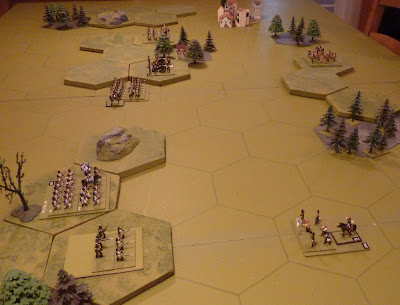General view of the battlefield at midday - the French are on the right
Later in the same week, but further north, a punitive expedition from the garrison of Jaca came into contact with guerrilleros from the Huesca area, near the hamlet of Ancenigo. The French had a brigade of 4 battalions of experienced infantry, plus the usual additional small battalion of combined light troops, together with a company of foot artillery borrowed from the fort at Jaca. The whole was commanded by Chef de Bataillon Fantaise, seconded from the 118e Ligne. His infantry included 1 provisional bataillon d’élite of line grenadiers and 2 of foot dragoons – again, picked men from a number of regiments. [Each of these units counted as “grenadiers” in the CCN rules, which gives advantages in melee and in morale tests]. His other battalion was Polish - from the 4th Regt of the Vistula Legion – more tough veterans.
He was opposed by a force of around 3000 guerrilla troops commanded by the sinister Gomez brothers. [The Spanish force had been expected to be rather larger than this, but some of the troops failed to arrive – for the purposes of this campaign, bodies of Spanish irregulars can be greater or less than estimated, depending on dice rolls – the Hermanos Gomez were not lucky in this respect].
This was a much more conventional set-up battle than that at Olias earlier in the week – the French took position on two low hills, artillery in the centre, the Poles and the light troops on the right. Pedro Gomez, the elder of the brothers, had difficulty restraining his troops, who were worked up into a frenzy by a number of priests serving in the ranks. He directed his first attack against the more lightly manned hill on the French right. The two leading bands of irregulars did not even reach the foot of the hill before they were broken by musket fire and disintegrated. Around the same time, roundshot from the French artillery caused another band to break up in the centre.
Rapidly running out of men, momentum and ideas, Gomez threw another two units against the hills on the French right, and sent in his cavalry in a looping, uphill charge against the French left flank. Both of these attacks failed and broke up into crowds of fugitives. The Spanish force retreated in disorder into the hills around the Rio Gallego. The fighting had lasted exactly 22 minutes. If proof were needed, the day demonstrated that irregular troops are not best suited to this kind of warfare.
OOBs
French Force – from the garrison of Jaca, Navarra (Ch/Bn Fantaise) – approx 3500 men, 6 guns
Grenadiers Provisoirs (1 Bn)
Dragons (a Pied) Provisoirs (2 Bns)
1/4e Vistule
Part of 14/3e Artillerie a Pied (Capt. Plantaine)
Loss – 30 men
Spanish Force – Junta de Navarra, commanded by Pedro and Jose Gomez – approx 3000 men
Loss – 1840 men
The big attack on the French right...
...didn't go well at all
The situation after about 20 minutes - the Spanish forces (on the right) have mostly disappeared
Poles and skirmishers on the French right, who took most of the weight of the attack - all the French casualties were sustained in this area
This and the remaining pictures were taken by my young son, who is very interested in close-ups - here's some foot dragoons, with Ch/Bn Fantaise close at hand
It's a hard life in the artillery
Guerrilleros retreating through the village
Irregular cavalry



















































